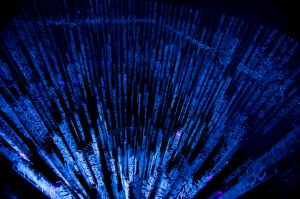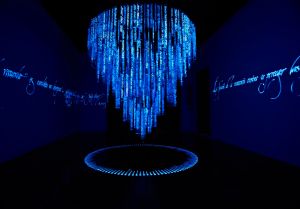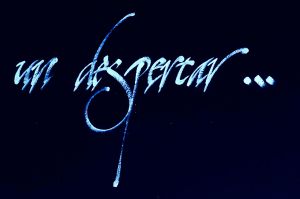Like ultraviolet rays, memory shows each man a script from the book of life, that invisibly and prophetically glosses the text. Walter Benjamin. One-Way Street[1]
Apparitions (580 acrylic plaques inscribed with the names of the “disappeared” (victims of clandestine, political abductions) in Mexico, from 1972 to 1998. Based on figures provided by the Eureka Committee (Committee for the Defence of Prisoners and Mexicans politically persecuted, disappeared or exiled) and H.I.J.O.S (which stands for “Sons and Daughters for Identity and Justice against Oblivion and Silence). The inscriptions appear and disappear, depending on the intensity of the ultraviolet rays.)
“Apparitions” addresses the notion of visibility and concealment as operations that connect the exercise of remembering. It seeks to establish a confrontational reflection on the mechanisms of forced disappearance as a form of State terrorism against the memory of social activists who struggled in the middle and end of the last century. On one hand, the State tries to disappear, both physically and symbolically, any type of action or concept that goes outside of the norms established by the hegemony, through its dissolution. It may do this by incorporation into the system, or through the creation of a supposed potential enemy that must be destroyed in order to safeguard the social order. In this sense, each disappearance constitutes the erasing a revolutionary text. On the other hand, the insurgency pushes for this constant restoration of memory, to maintain the meaning of their movement and to demand justice for all those disappeared and assassinated. This act of re-inscription can only be done through materializing memory. This is why mothers in the Eureka Committee walk together, with a photo of their disappeared sons or daughters hanging from their neck. As Walter Benjamin says in his text The Work of Art in the Age of Mechanical Reproduction:
“The cult of remembrance of loved ones, absent or dead, offers a last refuge for the cult value of the picture. For the last time the aura emanates from the early photographs in the fleeting expression of a human face. This is what constitutes their melancholy, incomparable beauty”[2]
The presence of the names of the disappeared, as an act of re-inscription from a poetic, spectral representation is the focus of this piece. It stages the tension between inscription and erasure, visibility and concealment: between the transience of remembrance and the perpetuity of memory. The installation consists of 580 strips of translucent plastic, placed to form a circular, spiral shaped, inverted cone. On each strip is written -in calligraphy and with invisible ink – the name of someone disappeared due to their political activity. In normal light, the strips look transparent; the inscription is activated with black light.
A series of lines appear on the ground, simulating a clock. On the walls, the following (paraphrased) text by Theodor Reik can be read: “The function of memory, is to protect our impressions; reminiscence aims at their dissolution. Memory is essentially conservative; reminiscence, destructive”[3] The installation has a black light installed with an automatic dimmer, which slowly turns the light on and off. This way, the inscriptions of the names of the disappeared become visible each time the black light is intensified, and disappear as the light is dimmed, as the tensions between light and obscurity, justice and impunity, memory and oblivion are shown in different shades. Simultaneously, the soundtrack plays testimonies of disappeared political activists and their relatives, and funereal sounds. Facing the politics of oblivion and the indifference of reminiscence, this piece constitutes a reinstatement from the darkness, from the other side, always hidden from the media, as a spectre of the tension between the State’s exercise of power and the resistance within class struggles.




